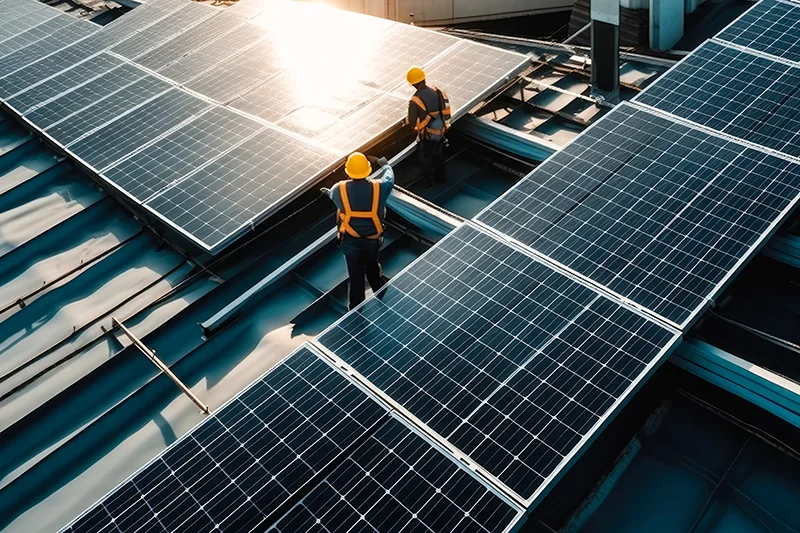California’s solar power plants now rival the scale of any in the world. What stands out most is how they were built: under union contracts.
From Labor Notes — By Keith Brower Brown —
Across the U.S., nearly 90 percent of solar workers had no union last year. In California, the situation was different—at least on paper. The vast majority of its solar power plants have been wrenched in place by unionized construction workers.
But at first these were union jobs practically in name only, as thousands of unionized solar construction workers toiled on the underside of a two-tier system. Their wages, training, and job security lagged far behind their union siblings. Many questioned if they were members at all.
“As a probationary, pay was $15 an hour or a little less,” said Pablo Perez, an Ironworker on major solar plants near Fresno. “I was one of 100 guys they brought in. When the job was over, you were done.”
Green concessions
Over the last few decades, many building trades leaders signed on to lower-tier contracts to get a foothold in residential and clean energy construction jobsites.
Around 2010, while other unions were still shut out of California’s growing solar power plants, the Electrical Workers (IBEW) began winning contracts—but at a cost. Temporary, lower-paid “construction wiremen” would fill about two-thirds of electrical jobs. Longer-term union members and apprentices split the rest.
Officers argued the repetitive nature of solar construction—often repeating the same 10 tasks of wiring and setting panels, for acres—didn’t require broadly trained, highly paid electricians.
Officials in the building trades often try direct outreach to persuade project developers to hire union, pitching them on safety, quality work, and fewer delays. But local Ironworker leader Don Savory in Fresno initially found it tough to convince solar developers to hire unionized contracting companies.
“When solar started coming, there were a few of them built non-union, paying $12 to $14 an hour,” he said. “At our package, $60 an hour [for wages and benefits], we weren’t getting traction.”
So as solar construction picked up faster, Savory proposed labor agreements that matched the IBEW’s tier ratios: five probationary Ironworkers for each fully trained “journeyworker” and apprentice.
Even compared to apprentices only two years into working iron, “probies” would get one-third less pay, and nearly none of the benefits. Instead of the union hiring hall that lined up a next job for apprentices, probationary workers finished their month or two of solar work with no guarantees to stay working union.
Unionizing a boom
The San Joaquin Valley, surrounding Fresno, is where Ironworker solar tiers started and ended. A few fields over is where the United Farm Workers struggled under vigilante gunfire.
In 2000, Fresno’s conservative city council passed the nation’s first ban on municipal Project Labor Agreements, a common deal used to unionize public work.
Meanwhile California’s state laws started pushing utility companies to shift to renewable energy: 20 percent clean by 2017, 50 percent by 2030, and 100 percent by 2045. Those mandates became a model for 27 other states, though the targets are usually less ambitious.
But California’s renewable laws lacked any explicit labor standards, let alone guaranteed union contracts.
Building trades unions made a stick out of the state’s environmental permit law. Like they had recently done to win concessions from gas power plant owners, unions threatened solar developers with lawsuits and mobilization to block permits until they signed a deal to unionize.
Just as important was a big carrot: unions could train thousands of new workers in the skills needed to build solar farms fast enough, even in remote corners of the state. Their apprenticeships, hiring halls, and mentorship gave them an edge over non-union outfits, which struggled to keep up with the demand.
As Ironworkers lined up their first few years of solar contracts, some local leaders pushed to get other unions included. Instead of competing over turf on each site, five trades agreed that stable, inclusive terms would mean steadier work all around.
By 2015, Electricians, Ironworkers, Laborers, Millwrights and Operating Engineers worked out a “five-craft agreement.” Their combined pressure made union labor the standard for all but one solar plant developer in California.
Probationary problems
Ironworker officers pledged that the solar two-tier would be temporary. Still, “the guys were hissing and booing” when Savory introduced the tiers deal at a local meeting in 2013. “I said, ‘This’ll get a foot in the door, then it’s up to you guys to make it better.’ ”
Unlike some other trades with appointed officers, Ironworkers elect their local leaders from the ranks. In the “rodbusters” union, a culture of rowdy local meetings and contested elections often checks those who win.
CAPTION (above): Solar plant installation can involve several union jurisdictions, including IBEW electrical workers, Ironworkers, Laborers, Millwrights and Operating Engineers, but only 10 percent of solar workers have a union. The Ironworkers and other trades are changing that in California, but it is taking time and strategy. Adobe Stock photo
Suncoast Reinforcing is hiring!
If you’re looking for work, contact Suncoast Reinforcement for information about current openings.
We’re nearly always hiring skilled ironworkers, supervisors and helpers.


0 Comments